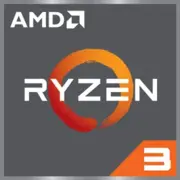AMD Ryzen 3 PRO 4350G

AMD Ryzen 3 PRO 4350G: Review and PC Building Recommendations for 2025
April 2025
Despite the emergence of new generations of processors, the AMD Ryzen 3 PRO 4350G remains a popular choice for budget builds. This APU combines performance, energy efficiency, and integrated graphics, making it versatile for a range of tasks. Let's explore who this chip is suitable for and how to use it effectively.
1. Key Specifications: Architecture and Performance
Codename and Process Technology
The processor is built on the Zen 2 architecture (codename Renoir) and manufactured using TSMC FinFET's 7-nanometer process. This ensures low power consumption (TDP of 65 watts) and high efficiency.
Cores, Threads, and Cache
- 4 cores / 8 threads thanks to SMT technology.
- 4 MB L3 cache, which is sufficient for basic tasks but may become a bottleneck in heavy workloads.
Integrated Graphics
The integrated GPU is the Radeon Graphics (based on the Vega architecture) with 6 compute units. It supports 4K displays and can handle light games like Dota 2 or CS:GO at medium settings.
Performance
- Geekbench 6: 1438 (Single-Core), 4621 (Multi-Core).
- In Cinebench R23 tests: ~750 points (Single-Core), ~3700 (Multi-Core).
Key Features
- Support for PCIe 3.0 (16 lanes).
- AMD PRO technologies for business tasks (security, remote management).
- Energy efficiency: even under load, the processor rarely exceeds 50–60 watts.
2. Compatible Motherboards
Socket and Chipsets
The processor uses the AM4 socket, allowing a wide range of motherboard selections:
- Budget: A520 (e.g., ASUS Prime A520M-K, ~$70).
- Mid-range: B550 (MSI B550M PRO-VDH WiFi, ~$120) — supports PCIe 4.0 for NVMe drives.
- Premium: X570 (Gigabyte X570 AORUS Elite, ~$200) — enhanced overclocking capabilities and more ports.
Choosing Tips
- Ensure that the motherboard BIOS is updated to a version that supports Renoir processors (e.g., AGESA 1.2.0.7 and newer).
- For using integrated graphics, a motherboard with video outputs (HDMI, DisplayPort) is required.
3. Supported Memory
Type and Frequency
The processor operates with DDR4-3200 (officially), but many users overclock their memory to 3600 MHz. DDR5 and LPDDR4x are not supported.
Recommendations
- Optimal capacity: 16 GB (2×8 GB) in dual-channel mode.
- Example kits: Corsair Vengeance LPX 16GB DDR4-3200 (~$45).
- High frequency is crucial for integrated graphics: 3600 MHz memory can increase FPS in games by 10–15%.
4. Power Supply Units: How to Choose
Power Calculation
With a TDP of 65 watts and integrated graphics, a PSU rated at 300–350 watts is minimally sufficient. However, for future upgrades (e.g., adding a discrete GPU), it's better to go for a model rated at 450–550 watts.
Example Models
- Budget: EVGA 450 BR (~$40).
- Mid-range: Corsair CX550M (~$70) — modular design and 80+ Bronze certification.
Tips
- Don’t skimp on the PSU: low-quality units can reduce system stability.
- For builds without a discrete GPU, even a compact SFX form factor PSU will be suitable.
5. Pros and Cons of the Processor
Advantages
- Integrated Radeon graphics — no need for a separate graphics card for basic tasks.
- Energy efficiency — suitable for compact builds and HTPCs.
- Multithreading — 8 threads speed up rendering and encoding.
Disadvantages
- 4 cores — in 2025, this may be insufficient for professional tasks.
- PCIe 3.0 — limits the speed of modern NVMe drives.
- Limited overclocking potential — unlocked multiplier.
6. Use Cases
Office and Study
- Document editing, browsing (20+ tabs), Zoom conferences.
Multimedia
- Viewing 4K video, content streaming, light editing in DaVinci Resolve.
Gaming
- Integrated graphics: GTA V (30–40 FPS on medium settings), Fortnite (720p, 60 FPS).
- With a discrete GPU (e.g., RX 6600): games like Cyberpunk 2077 on medium settings.
Practical Example: A user built a PC with the Ryzen 3 PRO 4350G for a home theater. The system operates quietly, consumes little power, and plays 4K HDR without lag.
7. Comparison with Competitors
Intel Core i3-13100F (~$110):
- Pros: Higher single-thread performance.
- Cons: Lacks integrated graphics, more expensive.
AMD Ryzen 5 5600G (~$150):
- Pros: 6 cores, Vega 7 graphics (20% faster).
- Cons: Higher price, excessive for basic tasks.
Conclusion: The Ryzen 3 PRO 4350G excels in the budget segment due to its price (~$90–$100) and the presence of an integrated GPU.
8. Building Tips
1. Motherboard: Choose a B550 if you plan to upgrade to PCIe 4.0.
2. Memory: 16 GB DDR4-3200 is the minimum for multitasking.
3. Cooling: The stock cooler is adequate, but for quieter operation, the DeepCool GAMMAXX 400 (~$25) is recommended.
4. Storage: An NVMe SSD (e.g., Kingston NV2 500GB, ~$35) will accelerate system loading times.
5. Case: Mini-ITX (Cooler Master MasterBox NR200) for a compact build.
9. Final Verdict: Who is the Ryzen 3 PRO 4350G Suitable For?
This processor is an ideal choice for:
- Budget PCs: Office tasks, studying, internet browsing.
- Media Centers: Streaming content, HTPC.
- Entry-level Gaming Systems: With the addition of a discrete GPU.
Why is it still relevant in 2025?
Its low price, energy efficiency, and integrated graphics make it a worthwhile option for those not wanting to overspend on newer models. However, for professional tasks (3D modeling, video editing), it's better to consider processors with 6 or more cores.
If you're building a PC for home or small business use, the AMD Ryzen 3 PRO 4350G is a reliable and economical option that hasn't become outdated even years after its release.
Basic
CPU Specifications
Memory Specifications
GPU Specifications
Miscellaneous
Benchmarks
Compared to Other CPU
Share in social media
Or Link To Us
<a href="https://cputronic.com/index.php/cpu/amd-ryzen-3-pro-4350g" target="_blank">AMD Ryzen 3 PRO 4350G</a>